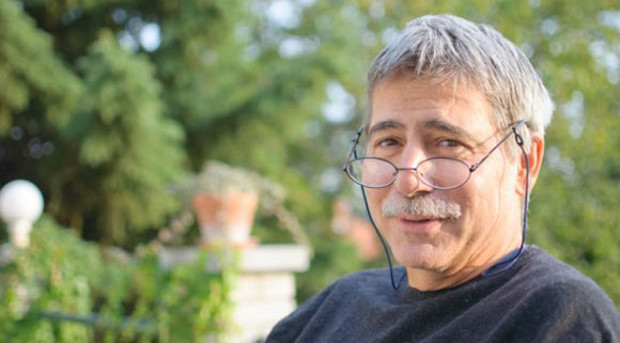
István Orosz is an eminent contemporary Hungarian graphic designer. He is also recognized for his work in the field of printmaking, painting, film direction and animation. His forte is mathematically inspired works, such as optical illusions, anamorphoses, impossible objects and double-meaning images. In fact, comparisons have been made between his work and M. C. Escher’s. He co-founded the Hungarian Poster Association.
Born on October 24, 1951, István Orosz grew up in Kecskemét, Hungary. Orosz received his formal art education from Moholy-Nagy University of Art and Design located in Budapest. Upon graduation in 1975, he started to work at theater as a stage designer and stepped into animated filming as film director and animator. He explored several branches of designing such as illustrating and printmaking. In his artwork while applying traditional printing techniques such as woodcutting and etching, Orosz enjoyed using double meaning images, illusionistic approaches and visual paradox.
His multifarious skills as an artist complemented each other. For instance, he would put to use the narrative mood of filmmakers while he was illustrating a book. His preciseness as an illustrator assisted him when he was designing a poster. Also he often used the several layers approach of etchers and engravers in his printing work. The critics believe that labeling him a poster designer is to oversimplify and narrow down his field of activity. Orosz’s artwork surpasses the classifications that have been made in the art based on different skills requirement. He boldly experimented with different art forms by juxtaposing them and applying as many innovative methods as he could.
In the first part of his career, Orosz was recognized for his poster designing. He designed various posters for cultural purposes and contributed to galleries, theaters, museum, publishing houses and movies. He drew some political posters during the 1989 revolution in Easter Europe. During this period, he came up with Tovarishi Adieu poster which symbolically represented the changing times and was displayed in many European countries. Besides, Orosz is best known for designing anamorphosis. It is a distorted projection of an image and in order to view the reconstituted correct image a certain vantage point or a special device is required. This technique was largely used by the artists of Renaissance era.
Orosz tried to revise the technique of anamorphosis as he gave meaning to the distorted image in his work. Therefore, the merely distorted image ceased to be an anamorph but an independent image in itself projecting its own meaning in the absence of a specified vantage point or a mirror. This art form is now deemed suitable for expressing more sophisticated messages through the disfigured images. Moreover, Orosz is prominent film director working at the PannóniaFilm Studio in Budapest. In the major international biennials of posters and graphic art, he regularly participates. In several different countries including Hungary, his work has been exhibited quite frequently. Some of these exhibitions occurred at I Space Gallery, Chicago, Escher Museum, Ernst Museum, Glen Eira City Council Gallery and Koller Gallery.
As a filmmaker he directed movies such as Towards to the Salt Celler (1978), Private Nightmare (1980), The Garden and Black Hole – White Hole (2001). In fact, he won the Best Script award at the 1st KAFF Animated Film Festival for Ah, America. He holds the lectureship at University of West Hungary in Sopron and membership of Hungarian Art Academie and Alliance Graphique International (AGI).

